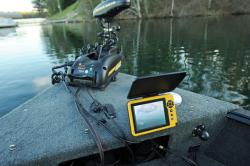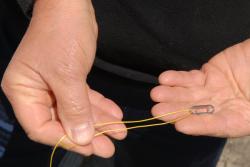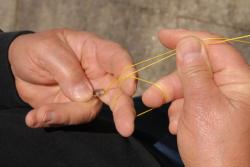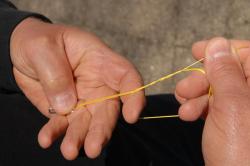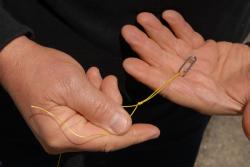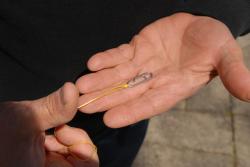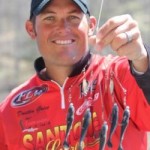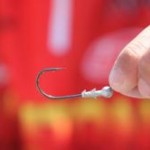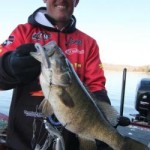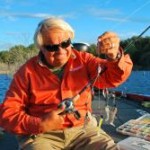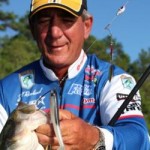“OUT of the hills of Habersham, Down the valleys of Hall, I hurry amain to reach the plain, Run the rapid and leap the fall.”
When poet Sidney Lanier wrote those words in “The Song of the Chattahoochee” little did he know the future of his river and the fantastic bass fishing lakes that would be built on it. Four of the most famous bass fishing lakes in the US are on the Chattahoochee River, and the middle two offer you some incredible opportunities this month.
Lakes West Point and Walter F. George, usually called Lake Eufaula, have some bass fishing characteristics in common but differ in many ways. Knowing those similarities and differences, and how to take advantage of them, can help you catch bass on both in May.
Although the upper end of Walter F. George is only a few miles from the West Point dam, the terrain changes dramatically from one to the other. West Point dam is near the fall line in Georgia. Above the fall line are rolling clay hills and valleys. Below it the land flattens out in sandy plains. This change makes the lakes very different.
West Point has more coves, pockets and cuts on it. The hills mean the water drops off quickly near the bank in most areas and the contour lines are usually close together. At Walter F. George huge flats line the banks and there are few coves and pockets on the main lake. Channels tend to wind through flats with shallow water on both sides. A contour map shows wide separation in the lines reflecting these big flats.
Both lakes are fairly fertile with West Point receiving a lot of rich effluent from Atlanta. What fertility is soaked up from the upper reaches of West Point to the upper end of Walter F. George is added back by discharges from Columbus and runoff from farms, so Walter F. George remains well fertilized. This means bass grow fast and fat from eating the large numbers of forage fish in both lakes.
West Point tends to have water that is a little more clear than Walter F. George, and the shoreline has more natural rocks. Although both lakes have populations of spotted bass, they have not taken off at Walter F. George like they have at West Point. Spots like to spawn on rocks in deeper water, so West Point is more suited for them.
The changing population of spots is reflected in the Georgia Bass Chapter Federation Creel Census Report compiled by Dr. Carl Quertermus at the University of West Georgia. In 1994 93.04 percent of the bass weighed in during club tournaments at Walter F. George were largemouth. Ten years later in 2004 88.7 percent were largemouth, less than a five percent change.
At West Point in 1994, 90.17 percent of the bass weighed in were largemouth. That dropped to 39.1 percent in 2004, more than 50 percent less. That is a huge change in the population of bass in the lake in only 10 years.
The size limits on both lakes has changed over the years but both lakes have had similar rules. For several years on both lakes largemouth had to be 16 inches to be kept, now the size limit on both lakes is 14 inches for largemouth. Spotted bass have no size limit in either lake, but most clubs require spots to be at least 12 inches long to be weighed in during tournaments.
Georgia and Alabama share both lakes, and rules have been adopted to make size limits and other laws similar. Both states have the same size limits and you can fish anywhere on both lakes with a Georgia license. You can fish all of Walter F. George with an Alabama license but are restricted to areas below the Highway 109 bridge over the Chattahoochee River at West Point.
Current plays a part in bass fishing on both lakes but is more important on Walter F. George. Since Walter F. George is a flatter, more shallow lake power generation at the dam produces a strong current and bass react to it by feeding on river and creek ledges. On West Point there is a good current at times and bass will feed better on main lake points when the water is moving.
You are not likely to see alligators on West Point but you can’t avoid them at Walter F. George. They really don’t affect the bass fishing but they can mess with your mind until you get used to them. Leave them alone and they will not bother you, in fact they will usually try to get under water and away from you as soon as you get in their area.
By the beginning of May most bass have finished spawning at both Walter F. George and West Point. They have started their movements toward main lake summer structures on both lakes. The ways to find and catch bass are similar in some ways but differ in others.
Ronnie Gregory fishes both West Point and Walter F. George, but spends more time on Walter F. George. He and partner George McWaters operate Eufaula Guide Services and take fishermen out on that lake. They also fish the Valley Tournament Trail as well as some of the R&R Tournaments and both those trails fish West Point and Walter F. George. Ronnie also fishes with the Spalding County Sportsman Club. (Ronnie and George took me out on Walter F. George before the 2004 Top Six the last week of April that year and put me on the fish that gave me 7th place in that tournament.)
Ronnie agreed to share some of his tactics for fishing both Walter F. George and West Point. He usually approaches both lakes with a tournament perspective, hoping to catch a limit of quality fish rather than catching a lot of smaller bass, but he has some tips for catching numbers as well as big bass, too.
Walter F. George
Most of the bass at Walter F. George have finished spawning by early May and are feeding up recovering from the spawn. They are starting to move toward their summer holes out on the deep main lake ledges, but some changes over the past few years has slowed that migration, making May fishing even better and more exciting.
Hydrilla got started in Walter F. George a few years ago and now covers enough of the lake to be a significant bass pattern. Couple the newer hydrilla with the water plants that have always been at Walter F. George and you have perfect ingredients for a great shallow water bite in May. Ronnie has been taking advantage of this shallow bite for the past two years.
Ronnie usually fishes the middle section of Walter F. George in May, working from Cowikee Creek down to the Barbour Creek area. He looks for hydrilla or “river grass” growing in two to four feet of water, and works it with a variety of baits. Buzzbaits and spinnerbaits are good, especially if you can find some shad still spawning. Both baits can be worked over the grass drawing strikes.
Most days Ronnie’s main lure is the Paca Craw, a hollow bodied soft plastic crawfish made by NetBait. This versatile bait can be fished on top like a buzz bait, you can swim it over the grass or you can drop it and fish it like a Texas rigged worm. Ronnie Texas rigs the Paca Craw in 15 pound Big Game Trilene line, a 1/8 to 1/4 ounce sinker depending on wind and depth, and a 3/0 hook.
Find a grassbed and start by fishing the Paca Craw over the top. The craws on the bait will flap and buzz, churning the water when you keep it on top. When the bait gets to the edge of the grass, let if drop and keep your line tight. Strikes usually come on the fall. If nothing hits, hop it a couple of times then swim it back to the boat for another cast.
An excellent area to try this technique is the Alabama shoreline from the mouth of Cowikee Creek down to Old Town Creek Park. This huge flat is covered in grass beds and is a good spawning area, so the bass are still here from the spawn. They will move to the grass to feed before moving deeper later.
Some bass will move on out on the ledges early in May and you can fish them all month, being ready when the majority of bass move out during May. This is classic ledge fishing at Walter F. George and you can catch bass on crankbaits and Carolina rigs all month long.
Ronnie likes a crankbait that will run about 10 feet deep and uses Trick and Finesse worms on his Carolina rigs. He looks for ledges toward the shoreline that are eight feet deep or so on top. Fish both crankbaits and Carolina rigs on these spots, and if stumps or brush is there it is even better.
There are some good ledges right where Cowikee Creek hits the main river as well as in the creek up to Lake Point State Park. There are even more good spots below the two causeways and the ones down to the mouth of Barbour Creek are some of Ronnie’s favorites. Ronnie likes to fish the first drop on these ledges.
A good lake map will help you find places to fish. Look for a bend in the creek or river channel toward the bank where the top of the ledge is less than 10 feet deep. Start in deep water casting up onto the ledge and fishing your bait back. Fish with the current if it is moving.
You will catch some spotted bass on Walter F. George on the ledges but they are usually not the bass you want in tournaments. To have some fun, find some rocks or brush on the ledges and throw your Carolina rig. When you catch one spot you are likely to catch several since they tend to school up and stay deeper in May.
The first point between Cowikee Creek and the river, on your right as you go out of the creek, is a good spot for spots. The creek channel swings in close on one side and the river channel is close on the others side of it. Fish it from both sides casting across it. When current is moving across this point and ledge fish your bait with the current and you should catch a bunch of spots.
West Point
On West Point Ronnie usually stays back in the smaller feeder creeks off the main lake from just above Highland Marina down to Wehadkee Creek. These creeks are excellent spawning areas and have deep enough water to hold bass all during May. He looks for cover along the outside bends of the creek channel and any points in the creek.
After spawning bass will move to cover in the 10 foot range and feed, holding there until the water gets too warm for them to stay. They take advantage of shad and other baitfish in the creeks as well as crawfish they find there. The key is to find some kind of cover on structure that will give the bass a good ambush point.
Bass at West Point seem to love a buzz bait and Ronnie will fish one over creek cover. He usually finds bass holding about half way back in the creeks and runs in part way before starting to fish. You can move fast and cover a lot of water with a buzz bait as you work into the creek.
The Paca Craw is also a favorite bait at West Point. Ronnie will fish it like a buzz bait all the way back to the boat if the fish are active. If they don’t hit it on top, he will cast it to the bank, buzz it a few feet to draw attention, then let if fall to the bottom. He can then fish it back to the boat along the bottom, hitting any stumps, rocks or brush there.
Every move of the Paca Craw will cause its craws to wave and move. You can either hop it and let if fall back or swim it along right on the bottom. Either way the bass seem to like it. If there is cover, hop it. If the bottom is fairly smooth, swim it along just over the bottom.
A jig and pig is also a good bait if the bass are holding tight in brush. It comes through thick cover better than the craw and Ronnie had real good luck with a jig and pig last May in the creeks off the river just upstream of the mouth of Yellowjacket Creek. He would pitch the jig and pig to the brush or blowdowns and work it slowly through them.
Toward the end of May largemouth start moving out to the main lake. Look for points with a drop on them in 10 feet of water and fish a crankbait or Carolina rig across it. Any drop on the point will hold fish. Some of the best are not real obvious, a one foot drop can be over looked by fishermen but the bass will use it. Fish with the current if it is moving.
This is a good time for big baits at West Point. Use big crankbaits like a DD22N, Fat Free Shad or Mann’s 20 Plus. Make them dig the bottom, stirring up silt as they bump along. Try big worms like a Zoom Ol Monster on a Carolina rig for bigger largemouth, too.
Spots on West Point tend to bed in deeper water where there is rock and gravel and don’t usually move as far back into the creeks. Find a gravel or rock point near the mouth of a feeder creek and drag a Carolina rigged Finesse or Trick worm along it.
A brush pile concentrates the bass. Rake the point from all angles and you should catch some spots up to about three pounds. You are likely to catch several spots in one place. Many tournament anglers try for a limit of spots first and then go after a kicker largemouth.
Try the points at the mouths of creeks below the Highway 109 bridge as well as marked shoals in that area for spots. Current really turns the spots on so head to them if water is moving. Fish with the current for best results.
Ronnie fishes lighter line at West Point since the water is more clear and there is less cover to hang up on. He throws his Paca Craw on eight to 12 pound test Big Game line and but goes to heavier line when pitching a jig and pig to thick cover.
Both West Point and Walter F. George are excellent lakes to fish this month. You can catch bass fairly shallow on both and the bass are hungry right after the spawn. Pick the lake you want to fish, try Ronnie’s favorite baits in the mid lake areas on both, and you should have a good catch.


